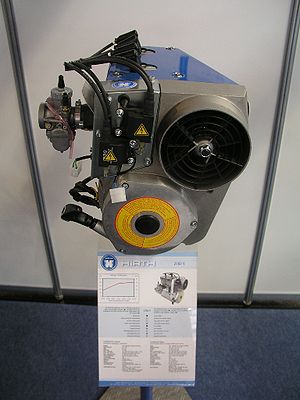- Dual ignition
-
Dual ignition A Hirth 2702 twin-cylinder, two-stroke aircraft engine. Equipped with dual ignition, the photo shows the two spark plugs per cylinder. Dual Ignition is a system for spark-ignition engines, whereby each cylinder has every critical ignition component duplicated, including spark plugs, magnetos and ignition circuits, rather than the more usual single spark plug or circuit. It is commonly employed on both two-stroke and four-stroke aero engines[1][2] and is sometimes found on cars and motorcycles.
Dual ignition provides two advantages: redundancy in the event of in-flight failure of one ignition system and more efficient burning of the fuel-air mixture within the combustion chamber.[1][2] In aircraft, redundancy is the most important consideration, but in other vehicles combustive efficiency is the prime aim.
Design
The provision of dual ignition in aero-engines is a safety feature to allow an aircraft to continue flying and land safely after an ignition system failure. Operation of aero engines on one magneto (rather than both) typically results in an rpm drop of around 75 rpm.[2]
While true dual ignition uses completely separate and redundant systems, some certified engines, such as the Lycoming O-320-H2AD use a single engine magneto drive-shaft turning two separate magnetos. Whilst saving weight, this creates a single point of failure that could cause both ignition systems to cease working.[2]
Another form of partial dual ignition that has been used on amateur-built aircraft uses a single spark plug, but duplicates the coil and pick-up for better redundancy than traditional single ignition.[3]
A further form of dual ignition on motorcycles has twin plugs but a single coil per cylinder. The HT current does not return via earth but via a second HT lead on the second plug. This system allows the cylinder to fire even if one plug becomes fouled; and the continuing combustion may burn off deposits, possibly enabling the fouled plug to clear.[citation needed]
Dual ignition promotes engine efficiency by initiating twin flame fronts, thereby obtaining faster and more complete burning and increasing power.[4] Although a dual ignition system is a very effective method of achieving optimum combustion and better fuel consumption, it remains rare in cars and motorcycles because of difficulties in siting the second plug. Alfa Romeo Twin Spark cars (by definition) use dual ignition, as do some motorcycles, such as the Honda VT500 and the Honda NT400 Bros[citation needed].
Wankel engines have such an elongated combustion chamber that even non-aero wankel engines may adopt dual ignition to promote better combustion. The MidWest AE series Wankel aero-engine has twin plugs per chamber, but these are placed side-by-side, not sequentially, so their main purpose is to give redundancy rather than improved combustion[5].
References
- ^ a b Crane, Dale: Dictionary of Aeronautical Terms, third edition, page 177. Aviation Supplies & Academics, 1997. ISBN 1-56027-287-2
- ^ a b c d Aviation Publishers Co. Limited, From the Ground Up, (27th revised edition), page 67, ISBN 09690054-9-0
- ^ Jodel.com (undated). "Dual ignition on auto engines without dual plugs". http://www.jodel.com/index.asp?p=dualignition&engines. Retrieved 2 August 2011.
- ^ van Elderen, Jan (2002). "Raceservice4u Twin plug systems". http://www.raceservice4u.com/Twin%20plug.htm. Retrieved 5 August 2011.
- ^ MidWest Engines Ltd AE1100R Rotary Engine Manual
Lists relating to aviation General Aircraft (manufacturers) · Aircraft engines (manufacturers) · Airlines (defunct) · Airports · Civil authorities · Museums · Registration prefixes · Rotorcraft (manufacturers) · TimelineMilitary Accidents/incidents Records Categories:- Ignition systems
- Gasoline engines
Wikimedia Foundation. 2010.

